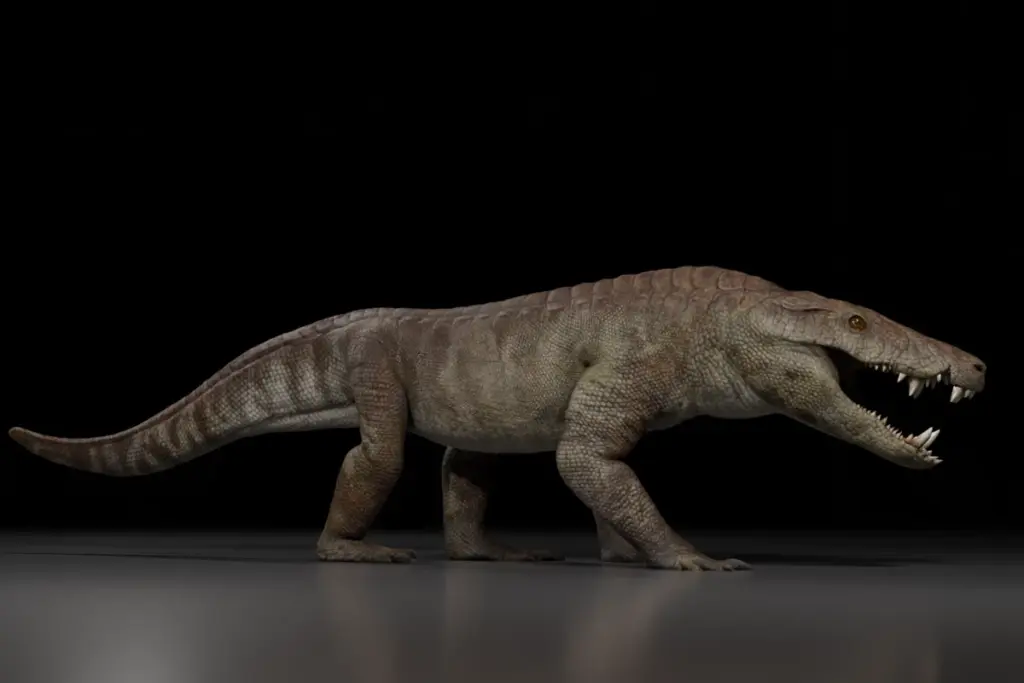
A remarkably preserved skeleton of a giant carnivorous relative of modern crocodiles has been discovered in Argentina. This find, unearthed near El Calafate, provides scientists with valuable insights into the physiology and behavior of this creature that roamed the Earth approximately 70 million years ago. The newly identified species, named Kostensuchus atrox, was a formidable predator that likely hunted medium-sized dinosaurs.
An international team of paleontologists, led by researchers from the Museo Argentino de Ciencias Naturales (MACN), reported the discovery in the journal PLOS One. The fossil includes an almost complete skull and jaws, marking it as the most well-preserved specimen of its kind. This new species belongs to the extinct family of crocodyliforms known as peirosaurids, which were predominant during the Cretaceous period in South America, Africa, and Madagascar.
The Kostensuchus atrox is estimated to have reached lengths of about 3.5 meters (11.5 feet) and weighed approximately 250 kilograms (551 pounds). Its distinctive short, deep skull featured powerful jaw muscles and blade-like, serrated teeth designed for slicing flesh rather than gripping it. This anatomical adaptation classifies it as a “hypercarnivore,” indicating it primarily fed on meat.
The name “Kostensuchus” draws from both Patagonian heritage and ancient mythology. The term “Kosten” originates from the Aonikenk (Tehuelche) word for the powerful Patagonian wind, while “suchus” refers to Souchos, the Greek name for the crocodile-headed Egyptian god Sebek. The addition of “atrox,” meaning “harsh” in Greek, emphasizes the creature’s predatory nature.
Insights into Cretaceous Ecosystems
The discovery of K. atrox significantly enhances understanding of the evolutionary tree of crocodyliforms. Prior to this, most known peirosaurids were represented by only fragmentary remains, leaving their full appearance and lifestyle largely speculative. The articulated skeleton of Kostensuchus allows researchers to explore its morphology and relationships with other crocodyliforms, leading to a clearer picture of its ecological role.
Researchers noted the anatomical differences between K. atrox and modern crocodiles, which typically employ a strategy of ambush hunting. In contrast, this ancient predator appears to have been an active hunter, capable of tackling its prey directly, which included various dinosaurs that shared its habitat. Fossils of medium-sized herbivores and smaller carnivorous dinosaurs have also been found in the same rock layers, suggesting a competitive ecosystem at the top of the food chain.
The findings stem from the Maastrichtian Chorrillo Formation, which exemplifies the diverse range of ecological niches occupied by crocodyliforms during the late Cretaceous. The research highlights that while dinosaurs were the most prominent predators, creatures like K. atrox also played a crucial role in their ecosystems.
As the last known representatives of a once-diverse lineage, today’s crocodiles, alligators, and gharials have descended from this varied group. The discovery of Kostensuchus atrox not only sets a benchmark for paleontologists studying other fossils but also illustrates the diversification of ancient crocodiles into specialized carnivorous forms shortly before the mass extinction event that wiped out non-avian dinosaurs 66 million years ago.
Overall, this groundbreaking find enriches our comprehension of the Cretaceous period and the evolutionary history of crocodyliforms, offering new perspectives on how ancient ecosystems functioned and how predators adapted to their environments.







